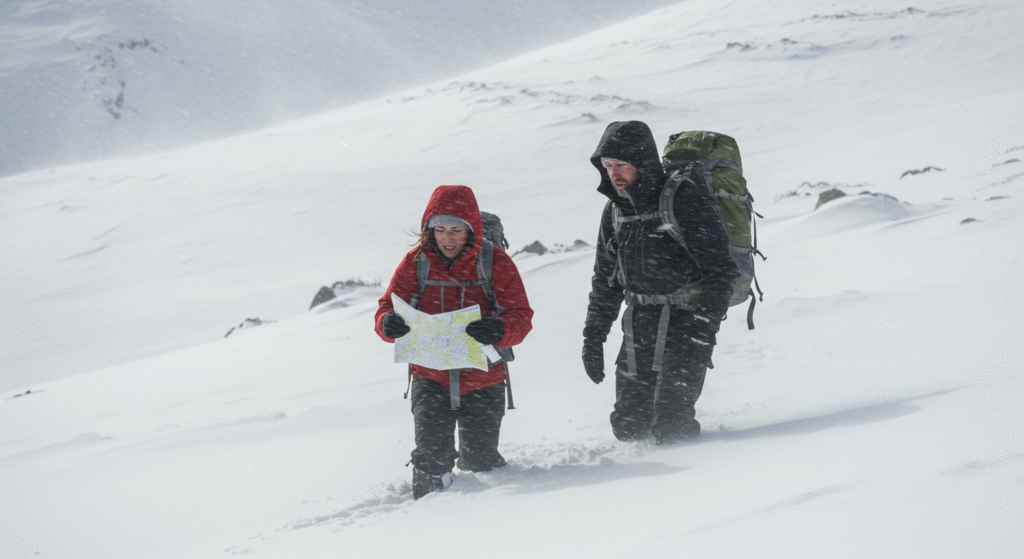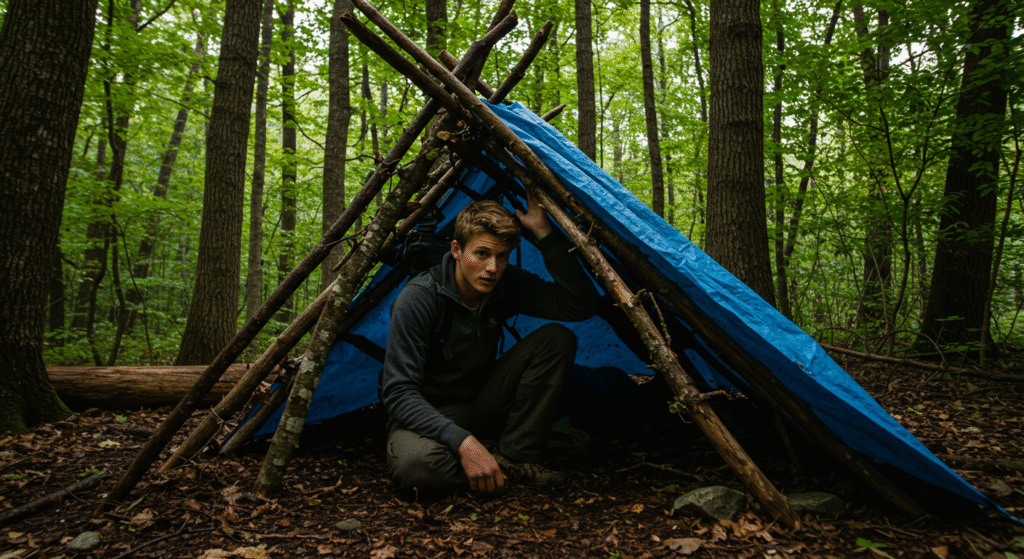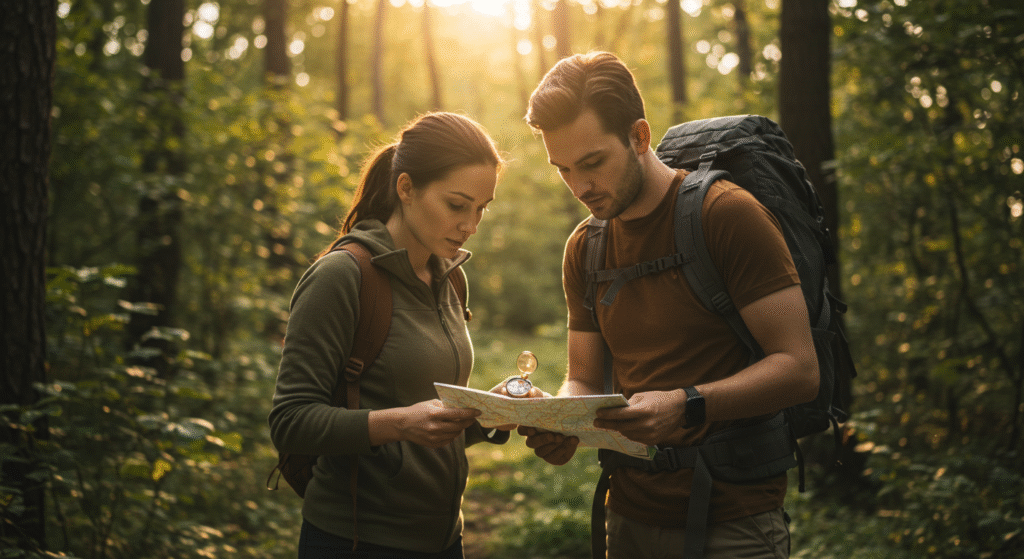Essential Survival Tips Every Explorer Wishes They Learned Sooner
Imagine you’re deep in the backcountry, miles from civilization, and suddenly the trail disappears. Your phone has no signal, the sun is setting quickly, and the temperature is dropping fast. Panic starts to rise, but you recall essential survival tips you’ve learned. You take a deep breath and focus on your next steps.
Survival in the wild often comes down to preparation, knowledge, and the right mindset. From sudden weather shifts to equipment failure or injury, nature throws curveballs when you least expect it. These essential outdoor survival tips will give you the confidence to explore further and stay safe, no matter where your adventures take you.

The Rule of Three: Survival Priorities in the Wild
When things go wrong outdoors, remembering the “Rule of Three” can save your life. This simple yet powerful framework helps you quickly assess your most urgent needs and prioritize your actions under pressure:
- 3 minutes without air: Without oxygen, irreversible brain damage can occur in just minutes. While it’s rare to lose access to air outdoors, this rule reminds us how quickly life can be compromised.
- 3 hours without shelter in extreme conditions: Exposure to cold, wind, rain, or heat can cause hypothermia or heatstroke faster than most realize. That’s why building shelter takes priority once breathing is secure.
- 3 days without water: Dehydration affects physical performance and cognitive function. Water sources can be hard to find, so locating and purifying water should be your next move after establishing shelter.
- 3 weeks without food: While hunger is uncomfortable, most people can survive without food for extended periods. That said, energy is crucial if you’re moving or signaling for help, so sourcing food comes last unless you’re in a prolonged survival scenario.
By focusing on immediate shelter, followed by hydration, and then nutrition, you dramatically improve your odds of surviving and making rational decisions in the wilderness. These outdoor survival tips are your foundation when time and resources are limited.
How to Find and Filter Water in the Wilderness
How do you find drinkable water in the backcountry?
Finding clean water is crucial. Look for signs of water in low-lying areas, near vegetation, or by following animal tracks. Rivers, creeks, natural springs, snowmelt, and even collected rainwater can be viable sources depending on the environment.
Once you find a potential source, it’s essential to purify it using one of the following methods:
- Portable water filters (like Sawyer Mini or LifeStraw): Lightweight and effective against bacteria and protozoa.
- Boiling: Bring water to a rolling boil for at least one minute (three minutes above 6,500 feet).
- Iodine or chlorine tablets: Compact and chemical-based solutions that kill most pathogens.
Always filter murky water before treating it and even treat clear-looking sources to avoid waterborne illnesses such as Giardia or Cryptosporidium. Proper water purification is a cornerstone of wilderness safety and one of the most critical outdoor survival tips you can practice.
Emergency Shelter Building Basics
Staying warm and dry can be the difference between survival and hypothermia. Whether you’re caught in a sudden storm or forced to spend the night in the wild unexpectedly, knowing how to construct a quick, effective shelter is essential.

Here are a few practical emergency shelter options every explorer should know:
- Tarp Shelter: One of the fastest setups. Tie a tarp between two trees, use trekking poles or sticks for support, and stake down the corners to create a windbreak. Adjust angles to account for wind or rain direction.
- Debris Hut: Ideal when you have no gear. Stack sticks to form a frame, then cover it with leaves, pine needles, or moss for insulation. Make the entrance small to conserve heat inside.
- Bivy Sack or Emergency Blanket: These ultralight tools take up almost no space but can save your life. Use them to wrap your body, line a natural shelter, or reflect body heat back toward you.
Gear Tip: Always carry these shelter essentials in your pack:
- A compact tarp or emergency blanket
- At least 25 feet of paracord
- A lightweight bivy sack or space blanket
These versatile tools weigh little but offer tremendous protection. Building shelter is more than a convenience, it’s a survival priority when the weather turns or night falls unexpectedly.
Fire Starting Tips That Work Every Time
What’s the fastest way to start a fire without matches?
Being able to start a fire in the wilderness is one of the most empowering outdoor survival tips you can master. Fire provides heat, light, the ability to cook food, and a huge morale boost when things get tough.
Here are three fast and reliable fire-starting methods that work even in wet or windy conditions:
- Ferro rod and striker: This is the go-to choice for most survivalists. Scrape the rod with a striker to produce a shower of hot sparks. Ignite fine tinder like cotton balls soaked in petroleum jelly, dry grass, or birch bark.
- Flint and steel: A classic method that still works today. Strike flint against carbon steel to create sparks. Catch them on char cloth, then build your fire gradually with kindling and fuelwood.
- Battery and steel wool: A modern trick. Rub a 9-volt battery against fine-grade steel wool. The current causes it to glow and catch fire. This works quickly but requires caution.
Pro Tip: Practice fire-starting in different weather conditions. Wet wood, wind, and cold can make even seasoned adventurers struggle. Always pack at least two fire-starting methods in your kit. Remember the phrase “One is none, and two is one”. Redundancy can save your life.
Navigation Tips When Tech Fails
Smartphones and GPS devices are fantastic tools, until they aren’t. Batteries die, signals drop, and electronics can break. That’s why one of the most timeless outdoor survival tips is learning how to navigate without technology.
Here’s how to stay oriented in the wild:
- Compass and map: Learn to read topographic maps and orient them using a compass. Practice following bearings and plotting routes before your trip so you’re not learning on the fly.
- Natural indicators: Use the environment as your guide. The sun rises in the east and sets in the west. Moss often grows on the shaded, north-facing side of trees in the Northern Hemisphere. Shadows and star patterns can also help you determine direction.
- Landmarks: Constantly track major features like rivers, ridgelines, or rock formations. Use these reference points to triangulate your position and avoid walking in circles.
Being able to navigate without electronics is more than just a backup, it’s a core survival skill that builds confidence, independence, and resilience.after their GPS failed. They stayed calm, identified landmarks, and made it out in 24 hours.
Must Have Survival Gear
A smart survival gear checklist can turn a dangerous situation into a manageable one. Packing the right essentials ensures you’re prepared for unexpected challenges and boosts your confidence on every adventure.
Always include these critical items in your pack:
- Water filter or purification tablets – Access to clean water is vital for survival and health.
- Fire starter (ferro rod or waterproof matches) – Reliable fire sources keep you warm and allow cooking.
- Multi-tool or knife – Versatile for cutting, repairs, and food prep.
- Emergency blanket or bivy sack – Lightweight protection against hypothermia.
- Headlamp with extra batteries – Hands-free light is essential for night tasks and signaling.
- First aid kit – Treat injuries promptly to avoid complications.
- Compass and topographic map – Navigation tools that never rely on batteries.
- Paracord (at least 20 feet) – Strong, flexible cordage for shelter, gear repair, and more.
- High-calorie snacks – Fuel your body for energy and endurance.
- Whistle or signal mirror – Simple but effective signaling devices to attract help.
Each item in this survival gear checklist supports the outdoor survival tips discussed above, helping you face emergencies with the right tools at your side.
Mental Strength and Staying Calm in Emergencies

Even the best gear won’t help if panic takes over. Mental strength is often your most valuable asset when facing unexpected challenges in the wild. Staying calm allows you to think clearly, make better decisions, and conserve energy—critical factors for survival.
Develop your mental resilience by:
- Practicing controlled breathing to reduce stress and maintain focus.
- Rehearsing survival scenarios before your trip so you’re mentally prepared.
- Using positive self-talk to manage fear, stay motivated, and build confidence.
In July 2024, 70-year-old Warren Elliott went missing while helping with trail maintenance on the Rubicon Trail in California’s Sierra Nevada. After taking a wrong turn and becoming disoriented, he managed to survive for five days by drinking water from a nearby river and eating a few wild berries. His story is a testament to human resilience at any age and highlights how even basic survival knowledge, like finding water and staying calm, can make the difference between life and death in the backcountry.
Remember, wilderness safety isn’t just about what you carry, it’s about how you respond. Knowing when to stay put, when to move, and how to improvise with limited resources can make all the difference.o includes knowing how to make sound decisions, stay put or move, and improvise with what you have.
Building Survival Skills for Any Adventure
These outdoor survival tips go beyond gear—they’re about mindset, preparation, and practical skills. From purifying water and building emergency shelters to navigating without GPS, mastering these essentials empowers you to handle whatever nature throws your way.
Before your next adventure, take time to test your knowledge, pack the right gear, and connect with fellow explorers by sharing your own survival tips. For more expert advice and gear guides, explore the full range of resources at Buckfish.com, and get ready to explore with confidence.
